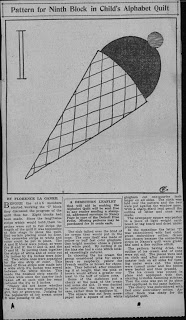 |
| Mildred's Block |
 |
| My Block |
Block 10-
The Jack-in-the-Box
The
surprised expression on Jack’s face as he popped out of his box was mirrored on
the faces of the quilt club members when they saw the pattern for the tenth
block on the alphabet quilt.
They began
to tell stories of the Jack’s they had had in childhood. One member recalled
other toys with springs with which she had played. There was the reptile
concealed in a simulated pot of jam. This snake uncoiled itself with frightened
suddenness when the top of the ham pot was lifted.
This
particular Jack was not difficult to appliqué since the spring and the face
were expressed in stitchery. The the rest of the toy was done in appliqué.
The first
step was the cutting of the square from the newspaper. **instructions for template making
and embroidering the letter are repeated again here**
While Nancy
was waiting for the pattern to dry she chose her other embroidery cottons. She was
sure to use only fast color, washable ones. For the hair she chose yellow, for
the mouth rose. And for the eyes she used brown. The same brown was used to
make the spring.
Now that
the pattern was dry she cut it, having the round pattern for the head, the two
long pieces for arms. The box was cut all in one piece. Where the arm expended
over the edge she acted as if it were not there and did not cut the indentation
left by its overlapping.
In cutting
all the pieces she allowed one=quarter inch on all sides for turning under. She
cut the face from pale pink, fast color soft gingham. The arms were from a
figured green print. The box was a pink and white material with pink dots
sprinkled over its surface.
After the
edges were turned under and basted down the pieces were pressed
She laid
the box in place on the lead pencil outline of the white block. The box was appliquéd
with fine, slanting invisible hemming stitches. Then she appliquéd the arms. The
head went on last.
To get the
effect of the box she used her brown fast color embroidery cotton and outlined
the lines of the box as shown. It was the line on the front toward the right
and the hinge line which needed to be stitched. The spiral spring was done in
fine running stitch.
The eyes
were outlined and the pupils worked in fine satin stitch. The mouth was done in
sating stitch. The eyebrows were in running stitch. The hair was done with
double strands of brown.









